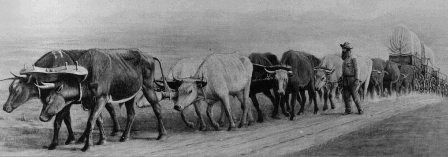
Although the coal found in the Coal Banks area was of a high quality and was potentially very valuable, the absence of efficient transportation to a market made the coal virtually useless. To remedy this, various methods of transportation were tried in the early years. Nicholas Sheran relied on the slow but dependable bull trains of that era. The bull trains of the 1870's were used for transporting trade-goods and supplies from Fort Benton, Montana to the North West Mounted Police post at Fort Macleod. But as the whiskey trade faded out, the use of bull trains turned mostly to coal transport.

P19760238891-GM A bull train making its way up an incline.
The bull trains consisted of 6 to 8 oxen hitched to three wagons, called the lead, swing, and trail wagons. The lead wagon would carry about 60 percent of the load, the swing wagon about 25 percent, and the trail wagon about 15 percent. In all about 15 tonnes of freight could be carried by a bull team. The bulls, or oxen, were broken in as four-year-old steers, used for about four years and then sold for beef. Bull train transportation however was only possible for about eight months of the year while pastures were available. It is not surprising then that bull trains would later be replaced by more efficient methods of transportation. The last bull train to pass through Lethbridge from Fort Benton was in the Spring of 1885, but bull teams remained in use for freighting in the Fort Macleod district until about 1889.
Previous Page | Exhibit Contents | Home | Navigation Information | Glossary | Curriculum Guide | Next Page
Copyright © 1996 Sir Alexander Galt Museum. All rights reserved.